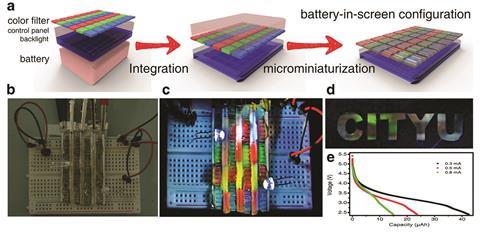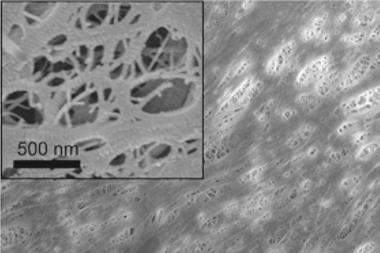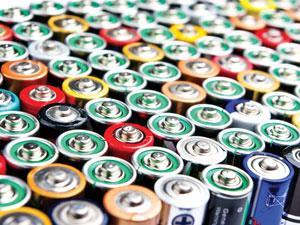Multifunctional component made from unique hydrogel electrolyte embedded with water-soluble photoluminescent quantum dots
Scientists in Hong Kong and China have combined a semi-transparent arrangement of anodes and cathodes with a transparent electrolyte to make the first ever photoluminescent microbattery that can simultaneously act as a power supply and a full-colour display.
The microbattery, developed by Chunyi Zhi from the City University of Hong Kong and his colleagues, works just like a conventional alkaline battery – redox reactions happen at the positive and negative electrodes, and ions diffuse through an electrolyte to provide electrical energy. Zhi’s microbattery, however, is a flat, sandwich-like arrangement of positive and negative electrodes, deposited on a transparent polymer surface with a transparent electrolyte filling.

Made of a mixture of gelatin and fluorescent quantum dots, the light-permeable electrolyte acts as a colour filter, one of the three key components of an LCD screen. ‘The fluorescent components emit fluorescence under UV irradiation, and the resulting light passes through the transparent electrolyte,’ comments Jian Lin, an energy storage and electronics expert at the University of Missouri, US. ‘By changing the fluorescent components, the battery can emit red, green and blue light. With the three primary colours of light, the microbatteries serve as a colour filter, realising the concept of a battery in a screen’, he adds.
Combined with an ultra-thin array of zinc anodes and manganese oxide cathodes, which are common battery components, the fluorescent microbatteries boast an exceptionally high energy density and could be cheap to produce on a commercial scale.

‘Our microbatteries deliver almost the highest energy density among micro-sized energy storage devices, and the highest energy density based on the whole microbattery volume,’ Zhi says.
‘It is far from commercialisation, but this novel concept will inspire more work on integrating electronic functions into one component for ultra-compact electronic devices,’ comments Lin.
Phone batteries are usually just less than 1cm thick. Zhi acknowledges that there is more work to do, but says ‘If the energy storage performance can reach the level of current batteries, the thickness of the battery and screen could be 90% thinner, leading to a whole new design of phones.’
References
This article is free to access until 22 June 2018
M Zhu et al, Energy Environ. Sci., 2018, DOI: 10.1039/c8ee00590g












No comments yet